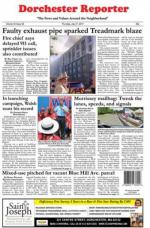August 6, 2009
A citizen task force working with the Boston Redevelopment Authority on a master plan for Columbia Point is recommending upping the number of affordable housing units that would be available on the peninsula under the plan.
The 15-member task force, appointed by Mayor Thomas Menino, took an informal vote urging any potential developers to designate 20 percent of the 4,300 residential units planned as affordable housing, instead of the city-wide standard of 15 percent.
“This is getting a sense of the committee†before the draft master plan goes to the public in September, said Don Walsh, co-chair of the task force and a member of the Columbia/Savin Hill Civic Association.
The percentages break down to developers having to put aside 860 units for affordable housing instead of 645. And it would also mean that “traditional Dorchester people†– those earning around $60,000 a year – would be able to afford to live in the area, Walsh said.
Walsh cautioned that the figure of 4,300 units is mainly “for planning purposes†and it’s unlikely the peninsula will reach that number.
But State Rep. Marty Walsh, a Dorchester Democrat, cautioned that the 20 percent figure might “hand-cuff†developers who may see profitability go down on a project if they have to set aside more units for affordable housing. “If it forces a developer to cut back on the project, I don’t think we get the full benefit here in Dorchester,†he said.
The informal poll occurred at the second meeting of the task force last Thursday at Boston College High School. A final vote on the proposed master plan by the task force, which is serving as an advisory committee to the Boston Redevelopment Authority, is expected after the September meeting for the public.
A number of businesses and institutions have Columbia Point addresses, including the John F. Kennedy Library and Museum, the Massachusetts State Archives, Corcoran Jennison Companies, the Boston Globe, Boston College High School, the Bayside Expo Center, and the UMass-Boston campus, among others.
The draft master plan, issued in July and spanning 20 to 30 years, estimates that after redevelopment of the area, annual property taxes could reach $23 million. State income taxes could potentially reach an annual $18 million.
Walsh, the task force co-chair, said one weakness of the draft master plan is that it doesn’t call for the fixing of Kosciuszko Circle before development begins. “It’s not stated in there,†he said.
Instead, the report calls for a study of the “design constraints†of the circle: “Critical to unlocking the development potential of Columbia Point is to more fully understand and address design constraints at Kosciuszko Circle, the Interstate 93 access ramps, and Morrissey Boulevard,†the report says. “To this end, the Master Plan calls for a comprehensive follow-up study and plan to analyze future traffic demand and formulate design solutions for these roadways.â€
A state transportation bond bill passed last year includes funds for the traffic study.
At an earlier meeting of the task force, a Boston Redevelopment Authority official said that tying “any single development to Kosciuszko Circle could have the unwanted effect of limiting economic development opportunities at a time when the City is seeking such opportunities,†according to task force minutes from that meeting.
Villages:
Tags:



